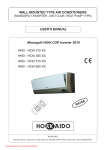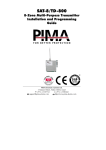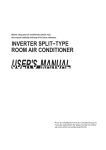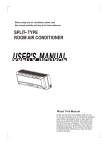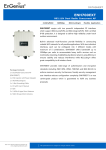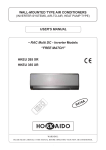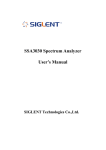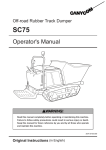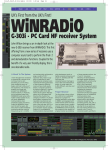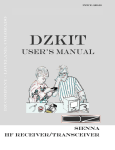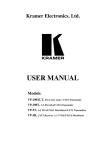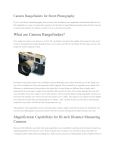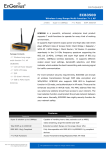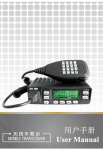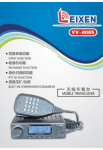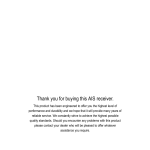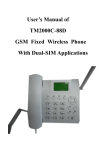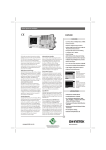Download T4047NB20 Manual
Transcript
Introduction of the New Model NB20 system adopts the latest RF technology, providing very high adjacent channel rejection ratio and anti-blocking performance, which gives rise to the outstanding anti-jamming capability of the new system. NB20 receiver can detect the frequency and amplitude of EMI interference with unbeatable accuracy and precision based on the extremely low self-noise of -125dBm. The RF performance of NB20 system surpasses the older 4047 systems several orders of magnitude. Furthermore, NB20 system takes high-speed processor for signal acquisition and output with very high precision. Its high efficiency transceiver can make full use of band width limitation and spend shorter time to work out data exchanging,and frequency calibration. As for operation, NB20 system is compatible with any receiver to construct a signal relay system. It is highly compatible with mature products on the present market, such as FUT, JR, HITEC, TDF, FS, XINYI etc. There is no need for consumers to change the old remote control system or any parameter settings to directly extend the remote control range. PWM output-and-input is one-to-one. It can relay signal with very high precision. By using the powerful forwarding of 20 channels, UAV’s parameter can be adjusted in the air, and the aerial cameraman and pilot could work together with single radio. In addition, one transmitter can be shared by several operators. As for the receiver, either EMI or RSSI signal can be displayed on LED, which allows debugging according to the visual signal strength. The new system is of longer remote control distance and higher reliability, because the source of interference can be more quickly and accurately ruled out. Comparison between the new and old models Similarities TX: The hardware operating frequency: 400-470Mhz Use three frequency hopping. Scan interfering frequencies before TX(i.e., Listen Before Talk). RX: The receiver has the spectral analysis ability with the range of 400~470Mhz, which leads to scan interfering frequencies of on board equipments in detail to select frequency band with lowest background noise. Differences (Values below are typical.) Differences Average RF power Sensitivity Adjacent Channel Rejection Anti signal-blocking Default operating frequency Signal of servo for transmission Signal of servo for output Input Mode Control Mode New model TS4047B20 Old Model T4047NB20 5w (peak number is 5.8W ) 1.6w (peak number is 2W) -115 dBm Very High -112dBm LOW Very High LOW 435+-2.5、 445+-2.5 、455+-2.5 、 433ISM 20 channels PWM output 20 channels PPM output 20 channels SBUS output 18 channels PPM, PWM,SBUS one to many 435+-10 、 433ISM(internal jumper settings) 10 channels PWM8 channels PPM 10 channels PPM \ PCM 1024-F One to one 4047NB20 System Operating Instructions Components and Functions Transmitter RF output Output interface is 50 ohm SMA socket. RF socket need to be connected to the antenna during the operation. If RF socket is open circuit or short circuit, the amplifier will be damaged by overheated. Power and Data socket DATA1: Data and power input socket 1 Input data is PPM or UART digital signal, which can be switched through SW3.Voltage range is 10~14VDC, typically 12VDC. Exceeding normal range of operation will result in increasing failure rate, or even permanent damage. DATA2: Data and power input socket 2 Functions are the same as DATA1. Notes: When using the PPM mode, 10CH PPM signal can be input through DATA1. The corresponding output of the UHF receiver is 1-10CH. DATA2 can also input 10CH PPM signal, the corresponding output of the UHF receiver is 11-20CH. When using UART digital signal, the functions of DATA1 and DATA2 are identical, either of which can be connected with signal acquisition system and input 20CH data. DIP Switch SW1 is designed for RF power selecting. “ON” indicates high-power mode, of which output power is 5W. The RF output warning tone is do, re, mi, fa.. “OFF” indicates low-power mode, of which output power is 2W. The RF output warning tone is do, re, mi. Note: There is no warning tone of do, re, mi, or do, re, mi, fa in debug mode. When used as a hand-held transmitter, please select low-power mode. SW1 will directly take effect when it is set before or after power on. SW2 is designed for Failsafe setting. “ON” indicates disable failsafe. Servos will remain on the last position after losing signal. “OFF” indicates enable failsafe. After losing signal, the receiver will read out servo position data which is previously stored in the receiver. Note: SW2 can only take effect when it is set before the transmitter and receiver power on. SW3 is designed for selecting input signal. “ON” indicates DATA1 and DATA2 can only input PPM signal. UHF transmitter is used for directly connecting to the remote control equipment. “OFF” indicates DATA1 and DATA2 can only input digital signal. It is used to connect the signal acquisition system. Note: When using the PPM signal, please select low power mode in order to avoid distortion of the PPM signal and the crash of remote control equipment.SW3 can only take effect when it is set before the transmitter power on. SW4 is designed for debug mode. “ON” indicates for enable the debug mode. Then the RF power amplifier will turn off, and the RF output will be very weak. This mode is used for checking whether the transmitting and receiving communication is normal. “OFF” indicates for the normal mode. Note: SW4 can only take effect when it is set before the transmitter power on. SW5 and SW6 are designed for select the output frequency. The frequency table is as follow SW5 is OFF&SW6 is OFF 435Mhz amateur bands SW5 is OFF&SW6 is ON 445Mhz amateur bands SW5 is ON &SW6 is OFF 455Mhz amateur bands SW5 is ON &SW6 is ON 433Mhz ISM band Please set the frequency according to the local law. Note: Changing the transmitting frequency will need the corresponding transmitter antenna. SW5 and SW6 can only take effect before the transmitter is power on. It is need to be rebind with the receiver again. If you want to change the output frequency, the corresponding antenna is needed. SW5 and SW6 would take effect when they are before the transmitter is power on, and, the transmitter needs to be rebind with the UHF receiver. Buttons PB1: The transmitter will be switched to binding mode by pressing this button before power on the transmitter. Keeping pressing this button for 5 seconds after power on the transmitter, the current servo position data will be stored in the receiver. PB2: The receiver will be switched to the data copy mode by pressing the PB2 button before power on the transmitter. RJ45 LED LED1: Valid data input indicator,of which lighting up indicates that valid data is being input. The data is PPM or 20CH digital data. LED2: RF output indicator,of which lighting up indicates that the current input data is being emitted into the air by the RF. The meaning of Warning Tones do, re, mi do, re, mi, fa mi, re, do mi, do, delay, mi, do do, delay, do, do, do, do, do ........ line fault. Starting to transmit in 2W mode Starting to transmit in 5W mode. Stop transmitting No signal being input into transmitter The transmitter is switched to the re-debug mode. Transmitter input signal is lost. There is input signal Signal Acquisition System Power Terminal 12V DC power input Data Terminal PIN1, PIN15 are ground. Connected to the negative terminal of the be-relayed receiver. PIN2, PIN16 are 4.8V positive power supply output, connected to the positive power of the be-relayed receiver. Note: PIN1-PIN2 and PIN15-PIN16, which internally parallel, can provide two berelayed receiver . Terminology: Be-relayed receiver - This receiver: does not refer to R4047NB20, but means the receiver which input data into the Signal Acquisition System, namely the original receiver of the remote control equipment, the R6203SB and R6014HS, for example. PIN3-PIN12 are PWM input, which are used to connect with the output terminal of the R6014HS’s PWM output. The FUTABA servo, for example, white wire of which is PWM signal. The PWM signal acquired by PIN3-PIN12 are corresponded to the CH1-CH10 PWM output signal of R4047NB20 receiver. PIN17-PIN26 are PWM input, which functions the same as PIN3-PIN12. The PWM signal acquired by PIN17-PIN26 correspond to the CH11-CH20 PWM output of R4047NB20 receiver. PIN13 is PPM input. If be-relayed equipment has PPM output interface, such as head tracker or the receiver with PPM output, you can use PIN13 to input signal to avoid cumbersome wiring. The PPM indicator lamp will light up when the valid PPM signal is detected. Note: PIN13 can input PPM containing 14 channels of data, while the the PPM signal rate should be larger than 30Hz. Moreover, the PPM content should be more than 4 channels of data, otherwise it will be considered as invalid signal or error signal. PIN14 is SBUS input. If you have receiver like R6203SB, you can use single terminal such as PIN1,PIN2,PIN14 to forward 18CH. If a valid SBUS signal is detected, SBUS LED will light up. PIN27 is the IDLE control terminal of the transmitter. The input signal is PWM signal. When the input pulse width more than 1.55 milliseconds, T4047NB20 transmitter will move to IDLE mode with no signal to be transmitted and IDLE LED will light up. When the input pulse width is equal or lesser than 1.55 ms, T4047NB20 will keep transmitting with the previous frequency. If there is no signal on PIN27 , then there is no operation. PIN28 is the IDLE control terminal of the transmitter. The input signal is logic signal. If there is no load, then no operation will be conducted,and the transmitter will be in the normal mode. When there is short circuit to GND, the transmitter will move to IDLE mode with no signal transmitting,and the IDLE LED will light up. When there is open circuit to GND, the transmitter will move to normal mode. Note: When input a mixed-signal, the PWM signal has priority over PPM, and PPM has priority over SBUS. For example, when SBUS and the PWM input at the same time, the corresponding servo signal of SBUS will be replaced by PWM signal and then be transmitted. When there is no data input, the signal acquisition system will not output data and the fault LED will light up . When there is any valid data input through PWM \ PPM \ SBUS, the signal acquisition system will output data stream, and the data output LED will light up. If the input signal is lost, the other channels besides CH3 and CH13 will transmit 1.5mS signal automatically. And the CH3 and CH13 will transmit 1.1mS signal. WARNING: Please correctly set ESC or the engine throttle control direction. 1.1 ms means engine cut. This is opposite to the default direction of FUTABA radio. If it is set incorrectly, the motor may suddenly start up under failure condition, leading to accident. Only CH3 and CH13 can be configured to throttle channel. If you want to use other channels to control the throttle, please handle it with caution. You should correctly set failsafe of R4047NB20 to avoid accidents. RJ45 ELD LED1: no signal input. Light-up LED1 means no input signal. By this time, no data will be output. T4047NB20 transmitter will send output regular alarm to indicate no signal. LED2: data output indicator. Light-up of LED2 means 20CH digital data is being output. Common Indicators PPM LED: It will light up after a valid PPM signal was detected. S.BUS LED: It will light up after a valid SBUS signal was detected. IDLE LED: The T4047NB20 transmitter will move to IDLE mode when the IDLE control terminal input pulse width is more than 1.55mS. By this time, IDLE LED lights up, which means there is no signal to be transmitted. Receiver Receiver Pin Definitions PIN1-PIN10 are CH1-CH10 PWM output PIN11 is CH1-CH10 PPM output PIN12 is CH1-CH18 SBUS output (compatible with the FUT SBUS) PIN13-PIN22 are CH11-CH20 PWM output PIN23 is CH11-CH20 PPM output PIN24 is RSSI output, which the maximum current is 20mA with 50 Ohms internal resistance. Buttons Press BIND and power on the receiver, then it will move to binding mode or copy mode. Press SCAN, and power on the receiver, then it will move to the interference scan mode. Common Indicators RF RX: When the receiver RX or TX (there is RF output under binding mode) RF RX LED will light up. DONE: It will light up when binding operation or F/S setting is completed. ANT1: Light-up of ANT1 indicates the receiver choose ANT1 RF signal. ANT2: Light-up of ANT2 indicates the receiver choose ANT2 RF signal. Signal Strength Indicator Note: The scopes of the indication of RSSI and EMI signal are the same. When indicate RSSI , the more LED lights the stronger signal is received and the situation is better. When indicate EMI, the more LED lights the stronger interference is received and the environment worse. LED1 - LED5 are all off: indicates that the input signal is less than-115dBm LED1 lit: the input signal is -115dBm to -109dBm LED2 lit: the input signal is -109dBm to -103dBm LED3 lit: the input signal is -103dBm to -97dBm LED4 lit: the input signal is-97dBm to -85dBm LED5 lights up when the input signal exceeds -85dBm The Calculation of RSSI Output Voltage Y = -120 + X / 20; Y: RSSI Unit is dBm X: RSSI voltage Unit is mV. Examples as follows: If the measured RSSI voltage is 900mV, according to the above formula, 900/20-120 = -75, then the actual received RSSI is-75dBm. If the measured RSSI voltage is 0.1V, according to the above formula, 100/20-120 = -115, then the actual received RSSI is-115dBm. (Minimum value) Installation Transmitter Installation Control Process Take FUTABA T12FG as example, T12FG transmits signals to R6203SB, and then R6203SB transmits the SBUS signal to the signal acquisition system, subsequently the signal acquisition system transmits signals to T4047NB20, following that T4047NB20 transmits UHF RF signal to R4047NB20, and R4047NB20 output 18 channels of PWM signals to each servo. The Installation of RF Part The antenna can be installed directly to the transmitter's RF interface. You can also use the RF cable with SMA terminal. The picture above shows the use of hand-held antenna. The picture above shows the use of car antenna(RG402 cable is recommended). Data Interface and Power Supply Connection The data interface is RJ45 interface, connected to the signal acquisition system with a flat 8-pin data cable. The signal acquisition system is powered by large capacity batteries or by a car cigarette lighter. Powered by a Cigarette Lighter The Connection with the be-relayed receiver Be-relayed receiver connect the SBUS signal to the signal acquisition system, or connect the PWM signal needed to be transmitted to any of the PWM input pin on the acquisition box. The picture above shows the PWM connection, in which CH12 connects to he IP interface. the 12FG settings allows the sync-transmit of 4047NB20 system and the 12FG. Under sync-transmit, 12FG powers on coupled with the 4047NB20 starting. And when 12FG is off, the 4047NB20 move to IDLE mode. The configuration of 12FG is as followed: The picture above shows FUNCTION settings. CH12 is controlled by SH. The picture above is 1-4CH Fail-Safe setted to HOLD. The picture above is 5-8CH Fail-Safe setted to HOLD. The picture above is 5-8CH Fail-Safe setted to HOLD, CH12 F / S +100%. The picture above is the SBUS Connection. NOTE: There has to be no electronic device within 30cm of the transmitter antenna, including the signal acquisition system and the be-relayed receiver. Because the strong radio influence is very likely to cause signal instability and it may also cause the malfunction or permanent damage of the be-relayed receiver. Anti-Interference and Safe Cabling Measures The picture above shows safe cabling method for the handheld antenna. There is no electronic device within 30cm around the transmitter antenna. If you use the car antenna, there is no need to worry much about the safe cabling in the car. The car antenna uses the RG402 cable or batter cable. The Installation of Cooling Fan Under high-power mode, you need to install cooling fans. You can firmly adhere it to the back of the transmitter with double-sided adhesive tape.The fan can be powered by any of the RJ45 socket on the transmitter. Erection of Transmitter Antenna One of the ways to install the transmitter is to elevate it by using a tripod or the roof, and the transmitter will be fixed by screws or adhesive tape. Another way is to install it in the car, using RF cable to connect with the transmitter. The picture above shows the elevated antenna on the balcony. The picture above shows the car antenna installation. The RD6014 needs to be fixed on the inside glass of the car. Note: Before locking your car, check whether the transmitter interferes with the locker to ensure that you can open the door. Receiver Installation Receiver installation During the receiver installation, relatively similar to gyroscope, the shock absorbing sponge is needed. Otherwise in the strong shock, Frequency drift of TCXO will reducing the signal quality. The Connection of the Servo, Antennas and Filters The servo insertion direction is as shown in the picture. If you have a filter capacitor, please insert it in socket of PIN24 . The picture above shows the connecting location of the filter capacitor and the connection of the receiving antenna. Note: The receiver antenna should not be too close to high-power RF output sources or T4047NB20’s antenna, otherwise the receiver will be permanently damaged or the signal will be blocked. The Recommended Layout of Installation The picture above shows the location of the receiver in the cabin. The picture above shows the position of ANT1 . The picture above shows the position of ANT2 and video transmitter. The video transmitter uses the RG402 cable, which is the same as the car antenna cable. The picture above shows the location of the image transmitter antenna. The picture above shows the position of the GPS antenna. Binding and Copying the Frequency Hopping Data Binding 1 Turn on all of the peripherals, the video transmitters, GPS, the autopilot, the video recorder and cameras. 2 Press the BIND button on the receiver then power up the receiver , and the RSSI indicator will blink. 3 Press the transmitter’s BIND button then power up the transmitter. 4 At this time, if the receiver receives the binding command, the RSSI indicators will be lighted and then extinguish one by one, which represent that the receiver is scanning the interference signal around in detail. This scanning process will probably continues for 5 seconds. 5 After scanning, the receiver's DONE indicator will be lighted and transmit the scan report to the transmitter.At this time, the receiver's signal strength LED will display the current highest EMI values in the employed frequency points. (The less the LED lights, the situation is better.) 6 The transmitter will sound continuous alarms when received the scanning report. 7 The binding is completed The third and fourth steps can be reversed Note: The bound receiver is unique ( the same as the TS4047 system), that is, if re-bound with other receivers, the previously bound receiver will be automatically blocked. Because during the binding process, different EMI scanning results may be detected, which causes the different hopping frequency lists of each bound receiver, while the same frequency hopping list between the receiver and the transmitter is needed by the normal frequency hopping control. WARNING: If you want to control two receivers A and B, you need to bind A receiver and then copy to B receiver. If you don’t use the copy function, the receiver A will be automatically blocked when the receiver B is bound, because of the existing of 3 bit scrolling mask (the former TS4047 system does not have this scrolling mask). Binding with B receiver for 8 times and then used with A receiver but didn’t re-bind A, the A receiver is likely to be come out of control and very unreliable. The Receiver Data Copy (Second Receiver Binding) This function upgrades and refines the former TS4047 system.If you must use two or more receivers at the same time, you must use the data copy function. The principle is to copy the frequency hopping data in the first bound receiver to the second receiver(there are the same frequency hopping data backups in the transmitter).This avoid the frequency hopping data discrepancies when receivers are bound separately. The operation is as follows, 1 Press the BIND on the receiver and then power up the receiver 2 Press the COPY button on the transmitter and then power up the transmitter 3 If the receiver receives the frequency hopping data, the DONE LED will blink 4 The copy is complete. The first and the second step can be reversed Note: The transmitter doesn’t alarm after the data copying completed. Warning: The receiver that has been copied can only work in the same electromagnetic environment. If any onboard device is replaced, use the DEBUG mode or the SCAN EMI mode for testing. Make sure the receiver is not be disturbed. The Settings of Failsafe After the system work normally, press the PB1 for 5 seconds to save the position data of every servo to the receiver R4047NB20. The failsafe data only works when SW2 turned to OFF.If the SW2 turned to ON, once out of control, the servo will keep the last position. The failsafe settings are effective for all the 20 servos. They cannot be turned off or set independently. Debugging The receiving sensitivity depends on the background noise of the plane. So to discover and adjust the position of the interference source is very important. Step one, no-load test for the receiver, After binding the receiver, only take a battery for the range test. Do not carry cell phones, cameras or any other electrical devices. The transmitter needs to enter the DEBUG mode, otherwise there will be no result after going several kilometers away.After the DEBUG mode is set, power the transmitter and at this moment, the transmitter will not produce warning tone of RF output.Under the DEBUG mode, the transmitter can have no antennas. Without the antenna, the remote range will be 5 meters, while with the antenna, the distance will be tens of meters.When the distance increases, the signal strength indicators will reduce one by one. When the signal is poor, the RX LED flashes irregularly, and the antenna selection indicator will switch frequently.If the distance is close or the signal is strong but the RX blinks irregularly, this means the current frequency band is very dirty. Generally the 433ISM band will be very dirty, because all industrial devices use this frequency band.If the test fails, you can change to another frequency band . Step two, after the receiver is installed, bind it after all airborne devices are started. This binding is intended to exclude the EMI interference from airborne devices. Quality certified products generally have good electromagnetic compatibility, but the others are likely to have electromagnetic leakage.The noise peak value in the UHF frequency components may be not small, and even the noise as weak as -100dBm may reduce sensitivity of the receiver seriously. After the binding is completed, the receiver will display the highest value of EMI in the current band. LED1-LED5 are off indicating the input signal is less than -115dBm LED1 is lit indicating the input signal is from -115 dBm to -109 dBm LED2 is lit indicating the input signal is from -109 dBm to -103 dBm LED3 is lit indicating the input signal is from -103 dBm to -97 dBm LED4 is lit indicating the input signal is from -97dBm to -85 dBm LED4 is lit indicating the input signal exceeds -85 dBm Under normal circumstances, the LED2 will light. In excellent case, only LED1 lights. If LED3 is lit, this means that you need to adjust the position of airborne equipment. Step three, adjust the position. The objects that need to be adjusted is the EMI interference sources. There are two ways to find the EMI interference sources: The first is to press EMISCAN and power the receiver. While moving the position of the onboard devices, observe the signal strength. When interference sources are close to the antenna, there will be higher signal strength displed. The second is set the the transmitter to the DEBUG mode and make range test. In extreme range, the RX light on the receiver will be blinking irregularly. At this time,the signal is in intermittent state. When the receiving antenna is near the EMI interference sources, the RX will become worse or even the signal will be blocked then RX turning to standby mode. When the interference sources are found, adjust the position of the receiving antenna and the receiver. The farther from the interference sources the better. The wireless video transmitter had better use the a separate battery and do not be connected on the same ground with the receiver battery.When using fuel engine, pay attention to avoid shocks. When using the gasoline engine, pay attention to the high voltage interference. Step four, tips for test flight. Check the autopilot, return switch's settings, whether the R4047NB20 is set with failsafe and whether the T4047NB20 needs to be shut down sync with your transmitter. Step five, if necessary, you can use the following simple method to test whether the output RF of T4047NB20 is strong enough.Take one cable with plastic cap removed. Insert a LED pinch the metal conductor with your finger, then the coil is close to the transmitter antenna. If the power is more than 2W, the LED lights. The LED is relatively brighter under 5W. Quick User Guide Control process: Take FUTABA T12FG as example, T12FG transmits signals to R6203SB, and then R6203SB transmits the SBUS signal to the signal acquisition system, subsequently the signal acquisition system transmits signals to T4047NB20, following that T4047NB20 transmits UHF RF signal to R4047NB20, and R4047NB20 output 18 channels of PWM signals to each servo. 1, connect the transmitter antenna 2, the transmitter's DIP switches are all turned to OFF 3, connect DATA1 and the signal acquisition system. 4. The signal acquisition system connects to the SBUS wire of R6203SB and R6203SB is powered with 4.8V power supply. The signal acquisition system itself has power supply output. So the connection to R6203SB just needs three wires. If there is no SBUS receiver .Connect PWM out to PWM in one by one. It will probably need a lot of wires. 5 Connect a 12V battery to the signal acquisition system . 6.Press the BIND on the receiver then power it and press the PB1 on the transmitter then power it,It will probably take less than 10 seconds to bind. If you prefer not waiting, just press PB2 then power it, and the binding is completed instantaneously. For the harm of PB2, see the above contents. 7 Connect the servos and turn on the FUTABA radio, it will work. Common Troubleshooting 1, The remote control distance is only 50 meters: A Check whether the transmitter is connected to the antenna. B Check whether the bottom of the antenna is hot. If so, the frequency of the antenna is wrong. C Check whether the transmitter still works in debug mode and whether the SW4 is in its normal OFF position. 2, Servo Jitter: A Check whether the previously used transmitted receiver jitter itself. The PPM signal may have this kind of situation. B Check whether the servo is interfered by wireless video or the transmitter. If high-power transmitters are in the vicinity of 20CM, this appears normal. C The signal acquisition system is too near the transmitter, or the wiring is very messy. D If using the SBUS input, the unused PWM cables must be pulled out. If the signal acquisition system is close to the transmitter, a cable may be induced impulse voltage above 7V.The signal acquisition system has PWM control priority, thus the false data caused by interfering signal will over write the SBUS data. E Check whether the servo is out of power. F Check whether the servo is broken, G 20 servos with four batteries will likely cause unstable power supply. 3, Bad use: A Check whether the receiver's power supply is normal, B check whether the UHF transmitter's power supply is normal, C check whether the previous devices are normal, D check whether the IDLE LED of the signal acquisition system is not lit. E check whether the be-relayed receiver is working or not and whether the power supply is connected to the right position F check whether the fault LED indicator on the signal acquisition system is not lit G check whether the transmitter has RF output tone. H Check whether the transmitter and receiver are bound. Generally the factory setting is not bound. 4, The OSD image cannot be switched and the return switch is not work: connect a servo to try whether the switching channel is in good use, If it is in good use, then the problem must be the OSD and the autopilot itself or the compatibility. The R4047NB20 not using PWM time-share output, but the PWM simultaneous output. The high-end OSD and the autopilot both support PWM signal simultaneous input. The FUTABA high-end receivers (multi-channel PWM output) use the PWM simultaneous output.AVR MCU doesn’t have ability to decode simultaneous PWM input. If it is not in good use, one possibility is the cable of the be-relayed receiver is not connected firmly, or that channel of the be-relayed receiver itself has no signal, or there is something wrong with the remote control settings. If you cannot find the problem: for example, if you first use the CH5 switch, now try the CH6 or try CH7 and CH10 to judge whether it is the problem of the 4047NB20 system , or put CH4 to CH5 to see whether the CH5 can transmit normally. Common Precautions 1,Before using the car antenna, check whether it is in conflict with the car lock in case the door cannot be opened. 2, The transmitter's power is big, so it is likely to cause nearby electronic system to failure.Pay attention when you use. 3, When you use the transmitter, try to hang it in the car or in a high position.You'd better not hold it with your hand. If you must, switch it to small power mode. 4, Check whether the THR channel's failsafe is normal and whether the be-relayed receiver is set with proper failsafe. 5, The failsafe of R6203SB receiver will work when the 12FG is off. The failsafe of the R4047NB20 will work when the T4047NB20 is shut down, or in the IDLE mode or the signal is very weak. 6, When the T4047NB20 is in use, try not to cut the power off. If necessary, turn off the transmitter by using the IDLE control signal. 7,Do not connect a servo on the be-relayed receiver. The connected servo will damage the signal acquisition system by overheat. 8, Without a normal binding process, the probability of losing control will increase a lot. 9, If the receiver is tested without its antenna, you can only know whether the receiver work or not. It does not show whether the interference among the airborne devices. 10, The basis for selecting the receiver antenna is the PQT (digitally) not the RSSI (analog mode), so the antenna selection does not work under strong signal. It will work if the distance is increased. The RSSI antenna selection has the disadvantage of misjudging the interfering signal. In the PQT mode, if tested with only one receiving antenna, there may be a misjudgment in a short distance, because the RF switch only has 25DB isolation. (If you do not understand this paragraph, it will not affect your use). 11, If you disassemble the transmitter to adjust it without authorization, it may cause the amplifier self-excitation. It will cause the deterioration or damaging of the transmitter . 12, The receiver fears vibration because the narrow-band communication requires a high precision of frequency stability. 13, If the receiver is connected to many servos, there needs to be a very powerful power supply. The operating current for a micro servo will reach more than 1A. The operating current for a standard servos will reach more than 2A. 14, The poor quality servos would cause serious troubles. When there is a long distance, as soon as the servo moves, the RSSI indicator will blink. The replacement of high-quality servos would greatly help the long range. 15, The digital ground and RF ground for the R4047NB20 receiver are separated by a filter. If accidentally there is a short circuit of the power supply and RF ground, (MCX skin with the 12V or 5V short circuit), the R4047NB20 may be damaged. The MCX connector skin also cannot get in touch with the carbon fiber or other ground loops in case of interfering get in.

































